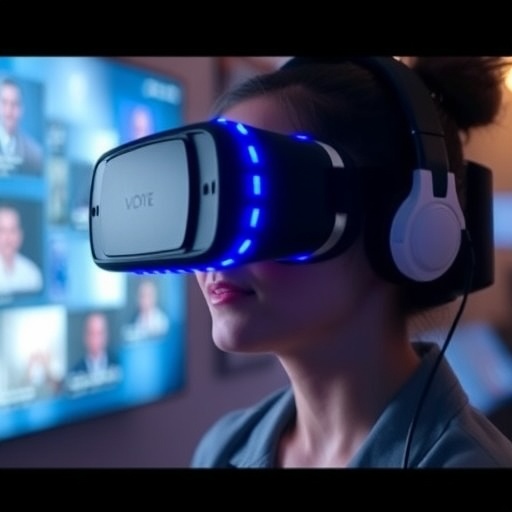As virtual reality (VR) technology continues to evolve at a breakneck pace, its integration into daily entertainment and professional environments has surged dramatically. VR headsets are now common technical peripherals that immerse users in digitally constructed worlds, delivering extraordinary sensory experiences mostly visual in nature. However, while the visual sophistication of these devices has drawn significant appreciation, questions surrounding their physiological impact—specifically on ocular health—have sparked critical scientific inquiry.
One of the primary concerns with extended VR use stems from the proximity of the display to the user’s eyes, often just a few centimeters away, creating a visual environment distinctly different from natural viewing conditions. Issues such as eye strain, visual discomfort, and potential exacerbation of dry eye disease have been reported by users and clinicians alike. Dry eye disease is characterized by instability in the tear film—the delicate fluid layer that coats the cornea—compromising both vision clarity and ocular surface comfort.
The tear film itself is a multilayered biological structure composed principally of aqueous and lipid layers. The aqueous layer serves as a hydrating medium, while the lipid layer, produced by meibomian glands within the eyelids, functions to stabilize and retard the evaporation of the tear film. When balance between these layers is disrupted, it can lead to increased tear film evaporation, reduction in its protective function, and ultimately ocular dryness and irritation. Despite the purported risks, real-time monitoring of tear film dynamics during active VR use has remained elusive due to technical limitations in integrating observation tools within headset systems.
Addressing this critical knowledge gap, an innovative breakthrough developed by Associate Professor Yoshiro Okazaki of Waseda University, Japan, alongside Visiting Professor Dr. Norihiko Yokoi from Kyoto Prefectural University of Medicine, has yielded the first real-time observations of tear film behavior in VR environments. Their cutting-edge research, published recently in the prestigious journal Scientific Reports, employed a VR headset embedded with ultra-compact imaging technology specifically adapted for monitoring the tear film’s lipid layer interference pattern during gameplay.
This meticulous study involved 14 healthy volunteers who engaged in a 30-minute VR gaming session under close surveillance. Utilizing the integrated camera system, baseline readings and subsequent measurements at five-minute intervals during brief pauses revealed notable physiological changes. Most prominently, the lipid layer of the tear film demonstrated a significant increase in thickness, corroborated by rising interference grades. Simultaneously, researchers documented a measurable elevation in corneal and upper eyelid temperatures immediately following VR exposure, pointing to a controlled warm microenvironment created by the headset.
The physiological mechanism underlying these findings likely involves periocular warming promoting enhanced lipid secretion or spreading, leading to a thicker, more stable lipid layer. This is important because previous literature has established that increased lipid layer thickness is positively correlated with tear film stability, reducing evaporative dry eye symptoms. Consequently, the thermal microclimate generated inside VR headsets could inadvertently provide a protective, stabilizing effect on the tear film, countering some of the traditional concerns associated with near-eye digital displays.
Okazaki articulated the implications of this discovery with cautious enthusiasm, underscoring that while these results are not indicative of direct clinical health benefits or therapeutic claims, they offer essential insights into the microenvironmental interactions at play in virtual reality usage. This research pivots attention not solely to the user experience but also toward ergonomic and design considerations for developers crafting next-generation VR hardware tailored to promote ocular comfort.
Nevertheless, it is important to view these findings within the context of certain limitations. The study was narrow in scope, involving only healthy individuals with no pre-existing ocular surface disease, leaving the extrapolation of results to dry eye patients or those with meibomian gland dysfunction indeterminate. Furthermore, the absence of a control group without VR headset exposure renders it challenging to dissociate effects resulting solely from periocular warming versus the VR task itself.
Looking ahead, the research team intends to expand this foundational work by incorporating clinical cohorts alongside carefully controlled comparison groups to elucidate the interplay between VR use, tear film physiology, and ocular surface disease more comprehensively. Such efforts promise to provide pragmatic recommendations for VR exposure durations, headset design refinements, and individualized user guidelines aimed at safeguarding eye health while maintaining immersive digital engagement.
For VR headset users, these emerging data impart a dual message; while vigilance toward eye fatigue and dry eye symptoms remains warranted, the controlled environment within VR systems may confer unexpected benefits by fostering tear film lipid layer integrity through gentle warming. For engineers and designers in the VR industry, the thermal characteristics inside headsets are a critical parameter for optimization, balancing device performance with ocular physiology to enhance user comfort and safety.
As virtual and augmented reality technologies inexorably integrate deeper into fields spanning entertainment, education, healthcare, and remote work, delineating their full impact on human physiology is paramount. This pioneering real-time observational study constitutes a significant stride toward disentangling the complexities of ocular responses within VR contexts, heralding a new era of user-centric innovation rooted in biomedical evidence.
Ultimately, understanding and optimizing tear film dynamics under VR conditions not only ensures healthier prolonged use but also advances the broader agenda of designing technology that harmonizes with our biological systems, exemplifying the synergy between cutting-edge engineering and human wellness.
Subject of Research: People
Article Title: Time-course observation of tear film dynamics during VR headset use
News Publication Date: 26-Sep-2025
Web References: https://doi.org/10.1038/s41598-025-16634-w
References: Okazaki, Y., Yokoi, N., et al. Scientific Reports, Volume 15, September 26, 2025.
Image Credits: Yoshiro Okazaki from Waseda University, Japan
Keywords: Virtual reality, tear film dynamics, eye health, lipid layer, dry eye disease, periocular warming, corneal temperature, ophthalmic devices, biomedical engineering, immersive technology, user comfort, VR headset design




